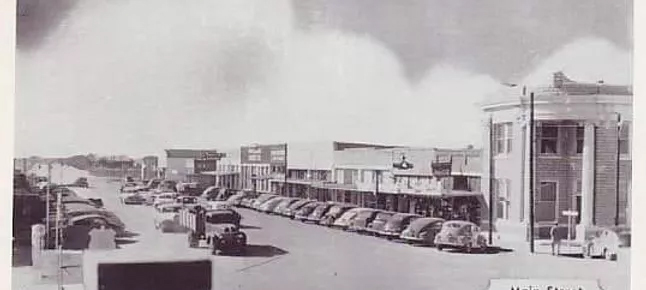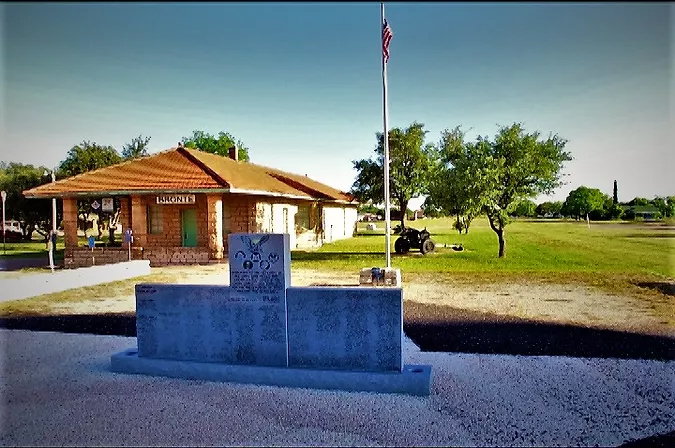
Bronte, Texas, on U.S. Highway 277 at its junction with State Highway 158 in east-central Coke County, was founded in the late 1880s and named for the English novelist Charlotte Bronte. J.B. McCutchen drove a herd of cattle into the area from Santa Anna in 1889, and other settlers followed, including Dr. W. F. Key, who started the town. Lumber was hauled from Ballinger and stonemasons used rock from quarries south of town to build the town’s early buildings. Both Oso and Bronco were chosen from the town’s original names, but the post office rejected Bronco to avoid confusion with another town. It is unknown why Oso was rejected, and eventually, the name “Bronte” was chosen. Bronte had a post office by 1890 and built a community building which was occupied by a church on Sundays, and school during the week. The town’s population was 213 in 1900.

The Kansas City, Mexico, and Orient Railway was completed through the area in 1907, and around this time Bronte was moved a mile to be near the track so it could become a shipping point on the railroad. The first train, however, reportedly did not run until 1909. In 1910 the town had a population of 635 and a number of businesses, including two cotton gins, a bank, a mercantile, and a newspaper. After torrential overnight rains in August of 1953, the Kickapoo Creek system which surrounds Bronte flooded, causing millions of dollars in property damage to homes and businesses. With federal support, the Kickapoo Water Control and Improvement District was founded to build flood control dams throughout the Kickapoo mountains to prevent future floods. Bronte’s population was reported as 999 in 1960, some 925 in 1970, 983 in 1980, and 962 in 1990. The population grew to 1,076 in 2000 but dipped to 999 again in 2020. Local tourist attractions include Fort Chadbourne and Bronte’s community park, which provides swimming, golfing, and fishing from Lake Knierim. Recreation areas in the vicinity include the beautiful Oak Creek Lake.

Bronte Depot
Built by local stonemason James C. Lammers (1874 – 1972), this depot was completed in 1911, two years after the first train arrived in Bronte. Built of locally quarried materials, the depot features stone lintels and window skills, and a red tile roof. Originally owned by the Kansas City, Mexico, & Orient Railways, the Bronte Depot was sold in 1928 to Atchison, Topeka, and Santa Fe Railway Company, which discontinued operations here in 1967. The Depot now belongs to the city of Bronte.
The Texas Theatre
Built and operated in the late 1940s by the Wojtek brothers, who also had the Alamo Theatre in Robert Lee, TX. Both theatres were in continuous operation from the 1940s until the late-1970’s and remains an icon for the Texas Historical Film Commission.
Historical Markers
Butterfield of Overland Stage Route
· Route of the Southern Overland Mail Line (Intersection US 277 and SH 70) One mile southeast to Fort Chadbourne, a station on the Butterfield Mail and Stage Line, which linked St. Louis and San Francisco. 1858-1861 the Fort was established in 1852, occupied until its surrender to State Forces in 1861, and garrisoned at times after the Civil War.
Southern Overland Mail 1858-1861 (Butterfield Stage) Passed neat this site, providing for the first time combined passenger and mail service between Pacific and Atlantic coasts. Operating west form St. Louis and Memphis, John Butterfield’s Company used 1350 horses and mules and 90 Concord Coaches and wagons. Stage traveled at a run, despite lack of good roads, a signal given approaching a station would have fresh horses ready and food on the table for crew and passengers. Route had stations 12 to 113 miles apart and was sometimes changed to get water. Crew and passengers wore guns to reduce the danger of Indian attacks. Mules (less coveted than horses) were used. West of Ft. Belknap, the trip on way took 25 days -seven spent crossing Texas, from Preston (now under Lake Texoma) to Jacksboro, Ft. Belknap, Ft. Chadbourne, and El Paso. One way fare for the 2700 miles was $200. Passengers rarely stopped off because they might not find seats on a later stage. Merchants in Jacksboro and other towns used Butterfield’s light freight service to make mail-order sales. The greatest contribution of the Overland Stage was its carrying news. Coaches also brought mail from the west 1 to 10 days faster than it came by ship. Service was ended in 1861 by the Civil War.
Fort Chadbourne, C.S.A. (Marker Location: 100 block of South Washington, Bronte) Located 8 miles north on Old Butterfield stage line. Upon secession, a company of First Regiment Texas mounted rifles occupied this post to give protection against Indians. Stopover on way west for many union sympathizers and people wanting to avoid conflict of war. Permanent personnel left the fort in 1862 when the frontier defense line was pulled back more than 50 miles east. However scouting parties and patrols of confederate and state troops used the Fort intermittently in aggressive warfare to keep Indians near their camps and away from settlements and to check on the invasion by Union forces. Usually supplying their own mounts, guns, and sustenance, these men guarded the frontier until the war’s end.
Indian Rock Shelters (Bronte Intersection of Texas SH 70 and US 277, about 8 miles N of Bronte) Throughout this area during the last several centuries, Rock ledges gave protection to Lipan, Kickapoo, Comanche, and Kiowa Indians. In one typical shelter archeologists found evidence of 3 periods of occupation, plus numerous intricate petroglyphs (rock carvings). River shells, turkey and deer bones, flint knives, scrapers, and points lay about the area. One of several hearths (2’ x 3’ in size) consisted of small pieces of sandstone lining a natural rock trough. On the highest level was found green bottle glass from nearby Fort Chadbourne (1852-1867).
Churches
First Baptist Church of Bronte (Marker Location: 424 South Washington Street, Bronte) Organized by visiting minister W.G. Green and a congregation of three on June 19, 1887, the Baptist church in Bronte originally met in homes. However, in 1890 a brush arbor was built along the banks of the Kickapoo Creek and the Rev. R.M. Cumbie was called as the first pastor. Services were later held in the community school in the winter and the brush arbor in summer. A Sunday school was organized in 1901 and the first church building was dedicated in 1907. A new building was completed in 1951. From its beginning, this church has been involved in missionary and community activities.
First Methodist Church of Bronte (Marker Location: 324 South Washington Street, Bronte) Marker Text: This congregation traces its history to the summer of 1890 when a small group of worshipers led by the Rev. J.W. Montgomery gathered under a brush arbor on east Kickapoo Creek to organize a church. Later that year the Rev. G.F. Fair became the pastor of the church, which met in an old schoolhouse. A sanctuary was built in 1907 and served the congregation until it was replaced by a new structure in 1951. Throughout its history, this congregation, which became First United Methodist church in 1968, has been involved in missionary activities.

